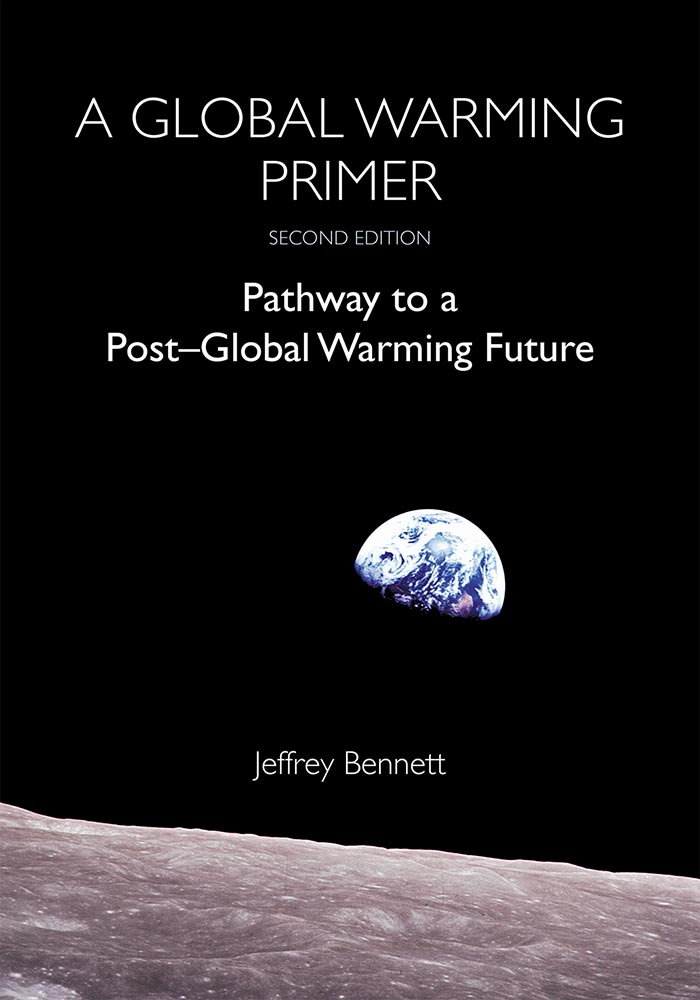 Note: These web pages offer the FIRST edition of the global warming primer for you to read freely. The NEW second edition (published 2024) is currently available only in book form (print $18; e-book $8). More details here.
Note: These web pages offer the FIRST edition of the global warming primer for you to read freely. The NEW second edition (published 2024) is currently available only in book form (print $18; e-book $8). More details here.
1 – The Basic Science 2 – The Skeptic Debate 3 – The Expected Consequences 4 – The Solution 5 – A Letter to Your Grandchildren Acknowledgments To Learn More
First Edition Text (published 2016)
“Preservation of our environment is not a liberal or conservative challenge; it’s common sense.”
— President Ronald Reagan, Jan. 25, 1984 (State of the Union address)
Introduction
Is human-induced global warming a real threat to our future? Most people will express an opinion on this question, but relatively few can back their opinions with solid evidence. This is true on both sides, as many “believers” are no better able to explain the scientific case for global warming than “skeptics” are to make a case against it. Many times we’ve even heard politicians and media pundits say “I am not a scientist” to avoid the issue altogether.
But the truth is, the basic science is not that difficult. Sure, Earth’s climate is complex, and therefore so are many details of the science of global warming, but I can tell you from my own teaching experience that the key ideas are understandable to most fourth- and fifth-graders. Indeed, even the more arcane details that you may hear debated in the media are usually simple enough once you focus on the heart of the matter. So if you want to understand and act intelligently on this issue, then I hope you’ll continue reading. By the end of this book, I believe you’ll be fully equipped to have an informed opinion about global warming.
Before we begin, let me tell you a little about the origins and goals of this book. The origins lie in my more than 30 years of experience in teaching and writing about science and mathematics. This experience has led me to conclude that one of the primary problems with science education (both in the United States and globally) is that we too often allow students — or the public — to get hung up on details before they understand the key “big picture” ideas. Global warming offers a prime example, because the media debate is filled with endless arguments about topics like the intricacies of computer models or climate feedbacks, even while the basic science is almost completely ignored. I’ve been fortunate to have had some success in offering a big picture approach to global warming with material I’ve written (along with coauthors) for my college textbooks and for a children’s book (The Wizard Who Saved the World), as well as with my online “global warming primer.” This book represents my attempt to take the same big picture approach to a wider audience.
As for goals, I’ll point you to three:
- I want to show you that anyone can understand the basic science of this issue.
- I want to help you understand the arguments you hear from skeptics, so that you can decide for yourself what to believe.
- I want to convince you that while the problem is real, it is also eminently solvable in ways that people of all political persuasions can agree on. Indeed, I believe that despite the “gloom and doom” you may have heard from others, the solutions not only will protect the world for our children and grandchildren but will actually lead us to a stronger economy, with energy that is cheaper, cleaner, and more abundant than the energy we use today.
As you will see, most of this book uses a question-and-answer format, with questions drawn from the many that I’ve been asked over the years. I hope that this format will make the book feel at least a little more like a personal discussion. You’ll also notice that the book uses two distinct font sizes. The normal font is for general text (like this introduction) and the big picture ideas that should be of interest to all readers, while this smaller font is for more detailed discussion that you can treat as optional, depending on the depth to which you’d like to go.
It is my fervent hope that this book will help you see through the fog of the media debate and the partisan battles to the simple truth embodied in the quote on the first page from Ronald Reagan: When it comes to preserving the environment in which we all live, we just need a little common sense.